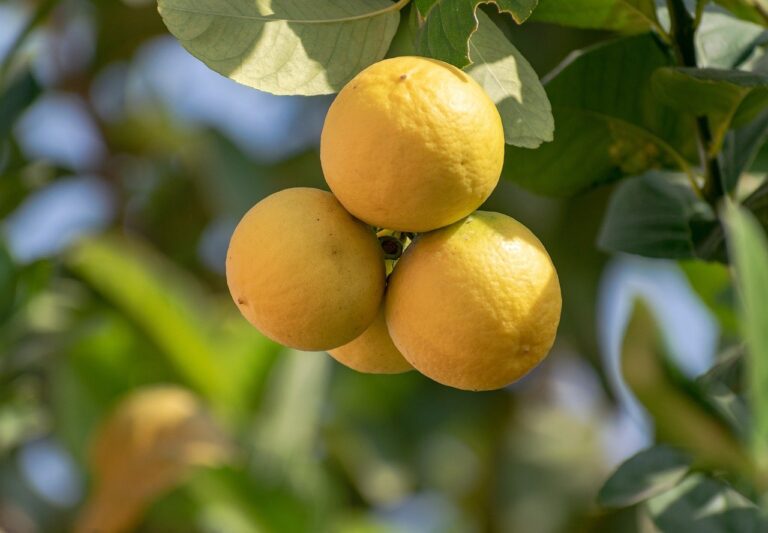Can You Grow A Lemon Tree Indoors?

Growing a lemon tree indoors can be a rewarding experience that adds beauty, fragrance, and the joy of fresh fruit to your home. With the right care and conditions, an indoor lemon tree can thrive and provide you with delicious lemons all year round.
Can You Grow A Lemon Tree Indoors?
Yes, you can grow a lemon tree indoors with proper care and attention. Indoor lemon trees are typically dwarf varieties, which are better suited for container growth and limited space.
These trees can be a lovely addition to your home, providing beautiful foliage and fragrant blossoms, as well as delicious fruit.
How To Grow A Lemon Tree Indoors?
To grow a lemon tree indoors, start by selecting a suitable dwarf variety and a spacious container with drainage holes. Fill the container with well-draining, slightly acidic potting soil and plant your tree, ensuring that the root ball is covered.
Place the container in a sunny location, preferably near a south-facing window, where it can receive at least 6-8 hours of sunlight daily. Maintain a consistent temperature of 65-75°F during the day and slightly cooler at night.
Water the tree regularly, ensuring that the soil remains consistently moist but not soggy. Fertilize your tree with a slow-release, citrus-specific fertilizer, and prune it as needed to maintain its shape and size.
What Type Of Soil Is Best For Growing A Lemon Tree Indoors?
The best type of soil for growing a lemon tree indoors is well-draining, slightly acidic potting soil with a pH of 6.0 to 6.5. This soil should be rich in organic matter, such as compost or aged manure, which can help provide essential nutrients and promote healthy root development.
A mixture of peat moss, perlite or vermiculite, and compost can create an ideal growing medium for indoor lemon trees. It’s also advisable to use a potting mix specifically designed for citrus plants, as it will have the appropriate nutrient balance and drainage properties.
How Often Should You Water A Lemon Tree Grown Indoors?
Watering frequency for an indoor lemon tree depends on factors such as the tree’s size, pot size, and environmental conditions. Generally, you should water your lemon tree when the top inch of soil feels dry to the touch.
This may mean watering once a week, or in some cases, even more frequently. It’s important to avoid overwatering, which can lead to root rot and other problems. Ensure the container has proper drainage to allow excess water to escape, and always use a well-draining soil mix.
Monitor your tree’s water needs carefully and adjust your watering schedule as needed, especially during periods of growth or changes in environmental conditions.
What Are The Best Conditions For Growing A Lemon Tree Indoors?
The best conditions for growing a lemon tree indoors include ample sunlight, consistent temperatures, and proper humidity. Position your tree near a south-facing window, where it can receive at least 6-8 hours of sunlight daily.
If necessary, supplement natural light with a grow light to meet your tree’s needs. Maintain a consistent temperature of 65-75°F during the day and slightly cooler at night, avoiding drafts and temperature fluctuations.
Indoor lemon trees also benefit from humidity levels around 50%, which can be achieved by placing a tray of water near the tree or using a humidifier. Additionally, proper soil, watering, and fertilization practices are crucial for a healthy indoor lemon tree.
How Long Does It Take To Grow A Lemon Tree Indoors?
Growing a lemon tree indoors from a seed can take several years before it begins to produce fruit. If you’re growing a grafted dwarf variety, it may begin to produce fruit within 2-3 years of planting, but it’s not uncommon for it to take up to 5 years or more.
Patience is key when growing an indoor lemon tree, as the process can be slow. However, during the waiting period, you can enjoy the beautiful foliage, fragrant blossoms, and the satisfaction of nurturing your tree from its early stages to a fruit-bearing plant.
Can You Grow A Lemon Tree From A Seed Indoors?
Yes, you can grow a lemon tree from a seed indoors, but it requires patience and proper care. Begin by extracting seeds from a fresh lemon, washing and drying them thoroughly. Plant the seeds in a well-draining, slightly acidic potting mix, and keep the soil consistently moist.
Place the container in a warm, sunny location, and expect germination within a few weeks. Once seedlings emerge, continue to provide adequate light, water, and nutrients to support their growth. Keep in mind that lemon trees grown from seeds can take several years to bear fruit and may not produce fruit true to the parent plant.
What Are The Common Problems When Growing A Lemon Tree Indoors?
Common problems when growing a lemon tree indoors include pests, diseases, and improper care. Pests such as spider mites, aphids, and scale insects can infest indoor lemon trees, causing damage to the foliage and overall health of the plant.
Monitor your tree regularly for signs of pests and treat them promptly with insecticidal soap or horticultural oil. Diseases like root rot can occur due to overwatering or poorly draining soil.
Yellowing leaves, leaf drop, and slow growth may indicate issues with watering, fertilization, or lighting. Address these problems by adjusting your care routine and ensuring your tree receives the proper nutrients, water, and light it needs to thrive.
Can You Grow A Lemon Tree Indoors Without Sunlight?
Growing a lemon tree indoors without sunlight is challenging, as these trees require ample light to produce healthy growth and fruit. However, you can supplement natural sunlight with artificial light sources such as full-spectrum LED grow lights or high-output fluorescent lights.
Ensure your tree receives at least 6-8 hours of light daily, adjusting the distance and duration as needed to mimic natural sunlight. Keep in mind that while artificial light can help support the growth of your lemon tree, it may not be as effective as natural sunlight in promoting fruit production.
How Big Do Indoor Lemon Trees Grow?
Indoor lemon trees typically grow to a height of 3-6 feet, depending on the variety and pruning practices. Dwarf varieties, such as the Improved Meyer lemon or Ponderosa lemon, are better suited for indoor growth, as they have a smaller, more compact size.
Regular pruning can help maintain your tree’s size and shape, making it more manageable for indoor spaces. Prune your tree to remove dead or diseased branches, promote air circulation, and encourage a balanced canopy.
Can You Grow A Lemon Tree Indoors All Year Round?
Yes, you can grow a lemon tree indoors all year round, as long as you provide the appropriate care and environmental conditions. Indoor lemon trees require consistent temperatures, ample sunlight, proper watering, and regular fertilization to thrive.
By maintaining these conditions throughout the year, you can enjoy a healthy, fruit-bearing lemon tree in your home. However, it’s essential to monitor your tree’s needs closely and adjust your care routine as necessary to accommodate changes in seasons or indoor conditions.
Should I Bring My Lemon Tree Inside?
Whether or not to bring your lemon tree indoors largely depends on the climate in which you live. Lemon trees, like most citrus trees, thrive in warm, sunny environments and are sensitive to temperatures below 50°F (10°C). In regions where winters can be harsh, it’s advisable to bring your lemon tree indoors to protect it from frost and freezing temperatures which could cause significant damage to the tree, even potentially killing it. Moving your lemon tree indoors for the winter can help ensure it continues to grow and produce fruit.
However, indoor environments can present their own challenges for lemon trees. The lower light levels and dry air typical of most homes can be less than ideal for these trees. When you bring your lemon tree indoors, try to place it in a sunny, south-facing window where it can receive plenty of natural light, and consider using a humidifier to maintain a good humidity level. Also, remember to gradually transition the tree from outdoors to indoors and vice versa to prevent shock. This process, known as “hardening off,” allows the tree to adjust to the new conditions gradually, increasing its chances of survival and continued growth.


